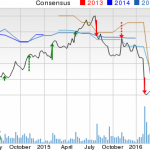
The general consensus among economists and financial analysts is that China was targeting a growth rate of 7% in 2015. That was before the Chinese equities meltdown that all but torpedoed China’s economic prosperity for the year. As can be seen from the chart below, the Chinese economy has been an economic powerhouse moving into 2015. Few if any economies of that size have been able to compare to the shear rate of growth that China is capable of. And what makes these figures even more impressive is that the growth rates are based on high volume capacity. Regardless of whether an analyst is considering the World Bank forecast or the Economist Intelligence Unit forecast, the trend is undeniable: China’s economic growth rate is sliding beneath the pivotal 7% per annum range for 2016.
The question is what will the 2015 growth rate look like?
The World Bank is expecting a GDP growth rate of 7.12% for China in 2015, the IMF is anticipating a GDP rate of 6.76%, the United Nations is anticipating a real GDP growth rate of 6.90%, and the Economist Intelligence Unit is forecasting a GDP growth rate of 6.80% for the current year. With the exception of the World Bank, all global authorities have revised China’s GDP for 2015 downwards.
Let us consider what this means for the world economy, and more specifically what it means for China’s major suppliers – the emerging market countries. GDP, more specifically real GDP, measures the growth in the value of all goods and services produced within a country’s borders in a particular financial year. When the GDP is increasing, this bodes well for services, manufacturing and the economy at large. It shows that the domestic economy is robust and improving. This is especially true when the forecast figures match with the actual figures.
Any disparity on the negative side will naturally tend to generate a bearish outlook for growth prospects. We already know that the Chinese economy has been subject to accelerated capital flight, a depreciating CNY, slowing PMI in industry and services, and growing dissatisfaction in terms of business confidence.












Leave A Comment